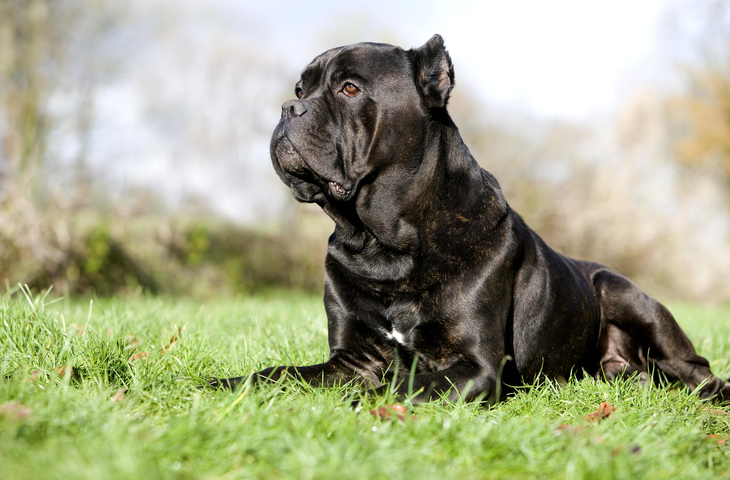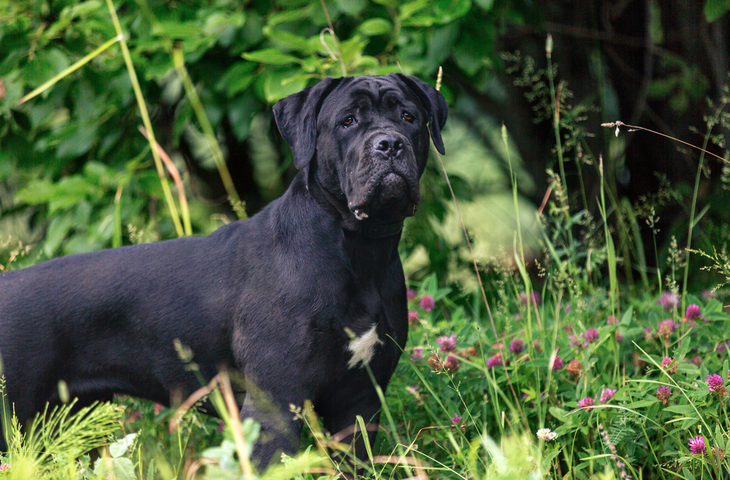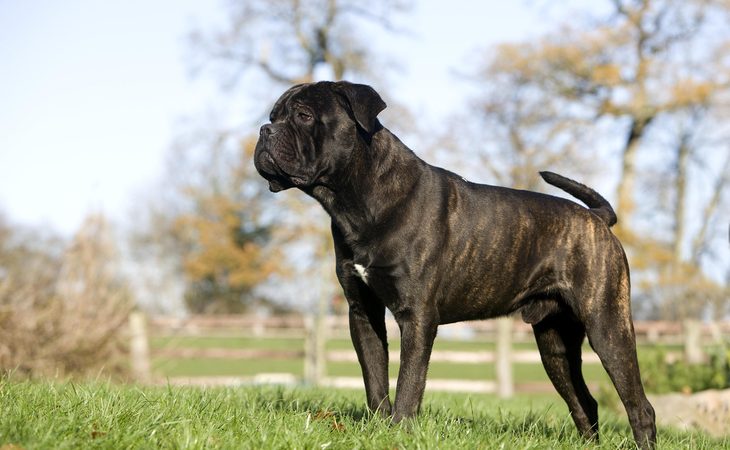Size: Large | Life expectancy: 10+ years | Temperament: Intelligent and calm | Coat: Short | Origin: Italy.
Cane Corsos are wonderful family dogs. They are appreciated for their calm, intelligent and observant nature. They are also known to be very hard-working dogs.
The origins of the Cane Corso
Cane Corso, Italian elegance
The Cane Corso, also known as the Branchiero Siciliano or the Italian Court dog, originates from Southern Italy. It is more precisely from the Apulia (Puglia in Italian) region.
Its name in Latin “canis corsus” means “protective dog”. This name perfectly represents the breed. Their ancestors used to be Roman army dogs in ancient times.
Aware of the invaluable physical qualities of this breed of dog, the Romans made these dogs go into the arenas where they faced gladiators as well as beasts such as lions.
The breed also disappeared but luckily, in the 70s, some breeders brought it back into fashion, first in Italy and then in Europe and America. We owe the return of the Cane Corso to Francesco Ballotta, Antonio Morsiani, and Paolo Breber.
A popular dog breed
It wasn’t until the 80s that the breed that Italy first recognized this breed. Later, France and other countries started to recognize this breed. In the United States, the Cane Corso is one of the most popular dogs.
The personality of the Cane Corso
The Cane Corso is above all an excellent companion for the whole family. It is a great protector and loves the outdoors. However, it is important to socialize this dog so that it adapts well not only to the whole family but also to strangers and other animals.

The Cane Corso’s qualities
This dog breed is sensitive and affectionate. It is also very protective and faithful. It is the perfect companion for the whole family. They also very intelligent and respond very well to strict training. It is important to socialize them from a young age.
You can train your dog in sports such as agility courses and tracking. It is athletic and needs to exercise every day. This dog can also be a perfect herdsman because it enjoys having missions and being at the service of its masters. Life in the mountains or in the countryside suits this dog breed perfectly.
Are there any downsides to having a Cane Corso?
This dog breed is a faithful and pleasant companion, however, it is necessary to be strict when training your Cane Corso. You should still be patient and not yell. Like many molosser type dogs, the Cane Corso is very intelligent, but also very independent. Because this dog breed is independent, it likes to do what it wants. If you do not train your Cane Corso while it’s a puppy, it can be uncontrollable, aggressive with strangers, or impatient with children.
The Cane Corso is active and needs entertainment. When bored, a Cane Corso might find something else to do. This could include attacking your furniture or belongings, barking incessantly, or digging holes. Lastly, the Cane Corso needs secure limits. Unfortunately, this breed is known to run away. Cane Corsos will do everything they can to try to leave, especially if your fence is not sufficiently reinforced.
The physical characteristics of the Cane Corso
This dog breed is very elegant. It is large with a slender, muscular, strong, and solid physique. This dog breed is very friendly, as long as it is trained well.
Head
The Cane Corso’s head is rather broad and its skull is slightly arched. Its nose is always black. The muzzle is deep and wide and its lips are thick and form an inverted U. This dog breed’s upper lips hang over its lower jaw. The jaws are as for them very broad and very thick.
Their eyes are medium-sized, slightly oval, and close together. When it comes to the color, it may vary depending on the coat. But it generally has dark, brown, or black eyes. Finally, its ears are triangular and of medium size. They are hanging when the animal is inactive and stand up when it is on the lookout or in an observation situation.
Body
The Cane Corso is strong and muscular. Its chest is broad, slender, straight, and imposing. The back is also straight and very muscular while the loins are short. The croup is long, wide, and just as muscular as the rest of the body. The Cane Corso’s legs are long and powerful, reflecting the stability and strength of the animal.

Coat, color, and care
Coat and colors
The Cane Corso is a short-haired dog breed. It also has a thin undercoat. The top coat is shiny and shows its muscular build. When it comes to the color of the coat, it can have nuances going from black to fawn while passing by variants more on the red side:
- Black,
- Shades of gray,
- Shades of dawn,
- Red.
Some dogs may also have white patches on their coat, such as on the tips or backs of their legs. They can also have a star-shaped white patch on their chest.
Grooming and care
This breed requires regular grooming. It is best to brush them at least once a week. It molts twice a year, which allows its coat to renew itself. During these periods, daily brushing is necessary. You should not bathe your Cane Corso unless its coat is very dirty. If you do have to bathe your Cane Corso, make sure to use a gentle dog shampoo.
Their teeth are prone to tartar. To keep their teeth clean, gums healthy, and to avoid bad breath, brush your Cane Corso’s teeth regularly. Like most dogs, it is best to trim their claws regularly. Lastly, keep an eye on their ears to avoid infections and redness.
Did you know?
The Cane Corso a strong, valiant, and fearless dog breed. In ancient Rome, ancestors of the Cane Corso were used to push lions back into their enclosures after fights organized in the Colosseum.
The Cane Corso at a glance
Size: 60 to 64 cm for females and 64 to 68 cm for males.
Weight: 40 to 45 kg (around 88 to 99 lbs) for females and 44 to 50 kg (around 97 to 110 kg) for males.
Health: It is a relatively healthy breed. However, it is necessary to watch for signs of hip dysplasia, eye diseases and gastric torsion.
Life expectancy: around 12 years.
Is the Cane Corso good with children? It can be a very good companion for children but it is necessary to socialize and train this breed.
Is this breed easy to train? This breed is not recommended for novice owners. It must be trained well with a good balance between authority, firmness and softness.

